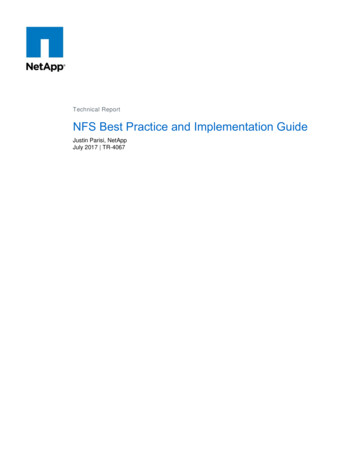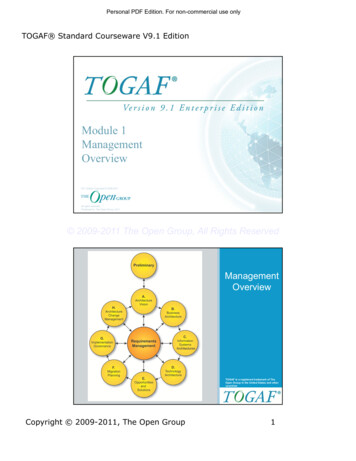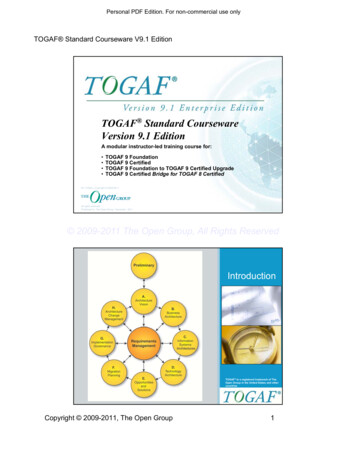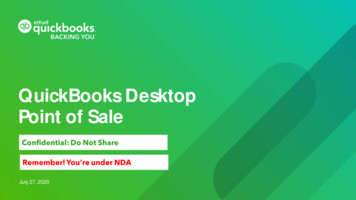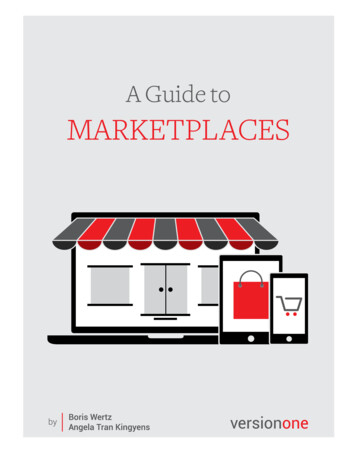
Transcription
ContentsIntroduction to Marketplaces5What’s a marketplace?. . . . . . . . . . . . . . . . . . . . . . . . . . . . . 6Marketplace types . . . . . . . . . . . . . . . . . . . . . . . . . . . . . . 7Selecting the right market. . . . . . . . . . . . . . . . . . . . . . . . . . . 8Success factors: how to win against the incumbent . . . . . . . . . . . . . . . 10Go vertical: The spawn of craigslist . . . . . . . . . . . . . . . . . . . . . . 12Marketplaces and network effects . . . . . . . . . . . . . . . . . . . . . . . 13Seeding, Growing, and Scaling a Marketplace16Stage 1: Seeding a marketplace . . . . . . . . . . . . . . . . . . . . . . . . 16Stage 2: Growing a marketplace: How to spark the virtuous cycle . . . . . . . . . 19Stage 3: Scaling a marketplace. . . . . . . . . . . . . . . . . . . . . . . . 20Finding the Right Business Model for Your Marketplace27Transaction fees vs. listing fees . . . . . . . . . . . . . . .27Enhanced seller services . . . . . . . . . . . . . . . . .28What to do when services are delivered offline?. . . . . . . . . . . . . . . . . 30Subscription fees. . . . . . . . . . . . . . . . . . . . . . . . . . . . . . 31Finding the right pricing strategy. . . . . . . . . . . . . . . . . . . . . . . 32New Marketplace Types34On-demand marketplaces (E.G. Uber, Lyft, Zeel) . . . . . . . . . . . . . . . . 34Managed marketplaces . . . . . . . . . . . . . . . . . . . . . . . . . . . 37Community-driven marketplaces. . . . . . . . . . . . . . . . . . . . . . . 38SaaS-enabled marketplaces. . . . . . . . . . . . . . . . . . . . . . . . . 39Decentralized marketplaces. . . . . . . . . . . . . . . . . . . . . . . . . . 40Marketplace Metrics41Marketplace Tools45Working with Investors47Conclusion52
INTRODUCTIONThe web changes everything. In just 25 years, the Internet has become so ubiquitousthat it’s hard to remember how things were done before.Nowhere is this more true than with how goods and services are exchanged. Not too longago, the marketplace was a purely local affair. Artisans and farmers brought their goods to thelocal marketplace to be sold. But when the marketplace moved online, it shattered the verynotion of local and global. You’re now able to buy anything and everything with just a fewclicks, and vendors have unprecedented access to a global audience.Let’s take books as an example. Used and rare books were once limited to tiny backstreetsellers. If they were lucky, book-lovers might happen upon a prized out-of-print editionwhile browsing the aisles. Moving the process online brought about a radical shift. Youjust need to type in an author’s name and title, and scores of choices will pop up frombooksellers all over the world. If there’s a book out there, it can be found. You can buy ahard-to-find copy of a used hardback from someone in San Francisco, read it, then sell itto someone else living in Dublin.Boris Wertz saw this transition first hand. Back in Germany in 1999, he launched an onlinemarketplace for books, JustBooks, which was acquired by AbeBooks in 2002. By 2008,AbeBooks was doing several hundred million dollars a year in transactions between buyerslooking for rare prints, limited runs, and used textbooks and the sellers who had them.AbeBooks was subsequently acquired by Amazon in 2008.As Boris saw, the online marketplace is a true example of a green-field opportunity.Whether it’s rare books or home repair services, an online marketplace brings buyers andsellers together in ways that were never possible before. It creates new buying and sellingopportunities. And, unlike an e-commerce site, anyone can build a marketplace withminimal capital requirements since there’s no inventory to buy, build, or manage.
As a result, the marketplace business model has attracted countless entrepreneurs. When amarketplace works, it works really well. There’s high potential for long-term profits at scale.And once a marketplace achieves liquidity, it’s hard for others to compete. That’s why youprobably can name only one online auction site.But, as many entrepreneurs find out, it’s hard to get the virtuous cycle of supply and demandto reach liquidity. You need to ramp up both sides in near unison. If there are buyers but fewsellers, the buyers leave. Yet if there are no buyers, how do you convince sellers to sign on?After AbeBooks was acquired by Amazon, Boris moved into investing, first as an angel andnow with Version One Ventures, with Angela Tran Kingyens joining in 2013. Over the pastdecade, Version One has invested in great marketplace companies, such as Indiegogo,VarageSale, Kinnek, Shippo, Headout, and Dwellable. We have learned from and helped manypassionate entrepreneurs looking to break down the walls for how goods are bought and soldin their particular space.What follows here are some of the insights we’ve learned while observing, funding, andbuilding marketplaces for more than two decades. There’s no single way to build and scale amarketplace, but we hope this handbook provides some insight to help you in your journey.Now let’s get to work.— Boris and Angela
1INTRODUCTION TO MARKETPLACES
Introduction to MarketplacesWHAT’S A MARKETPLACE?An online marketplace is a type of e-commerce site that connects those looking to provide aproduct or service (sellers) with those looking to buy that product or service (buyers). Thesebuyers and sellers may have had trouble finding each other before, and thus the marketplacecreates efficiency in an otherwise inefficient market.eBay’s launch in 1995 sparked the first wave of product-focused marketplaces, and Uber’ssuccess in 2010 brought a second wave of marketplaces for services. Today, we often see acombination of product and service marketplaces, particularly in food. For example, withDoorDash, customers order both the product (food) and the service (delivery).With the explosion of marketplaces, there are now sites to connect bands with music venues,homeowners with snow plowing services, and students with used textbooks.While these marketplaces spread across diverse market segments, there are two commonelements to every online marketplace:1. Marketplaces aggregate many sellers and their inventoryWhat sets a marketplace apart from a standard e-commerce site is that the goods and servicesare supplied by a third party. In most cases, the marketplace platform acts as a type of digitalmiddleman.However, the independence of suppliers is an increasingly grey area when it comes to servicemarketplaces. Most on-demand service marketplaces like Uber, Handy, and Postmates stressthe independence of their workforce, while other startups like Munchery in San Francisco andMyClean in New York switched to full-time employees, in order to gain more control over thecustomer experience.2. Marketplaces include a transaction elementA marketplace differs from a listing site by taking care of at least part of the transactionbetween buyer and seller. A true marketplace like eBay and Uber manages the entiretransaction, from listing to payment processing (with the service and goods delivered offline).For the purpose of this handbook, we’re also including those marketplaces where transactionsare initiated but not processed on the platform — for example, lead generation sites like6
Introduction to MarketplacesThumbtack where providers send quotes through the platform. We don’t consider a reviewsite like Yelp a marketplace, since there’s generally no transactional element involved(although Yelp is building more transactional capabilities like SeatMe and Book Me buttonsto its site).MARKETPLACE TYPESA marketplace can be categorized in terms of its participants (on both the supply anddemand side): P2P (peer-to-peer): This is a grassroots transaction where private individualssell their goods to peers. For example, the early days of eBay and Airbnb weredominated by private individuals. B2C (business-to-consumer): As a marketplace gains traction, its seller baseinevitably professionalizes as two things happen: 1) existing businesses see theopportunity and sign on to the platform and 2) private individuals find success onthe marketplace and formalize their activities into a business. B2B (business-to-business): While B2B marketplaces have lagged behind P2P andB2C, this is now a fast-growing segment. Alibaba is the biggest player in the group,and we’re seeing the emergence of a new wave of B2B startups, such as Kinnek,focused on making procurement and supply chains more efficient for the long-tailSMB market.FAST FACTS: TOP MARKETPLACESAlibabaEtsy8.5MM sellers (Q2 2014)1.4MM active sellers (Q1 2015)eBayUber25MM sellers (2014)1MM driver partners, 6x Y/YAirbnbAmazon2MM third-party sellers (Q1 2015)Nearly 25MM total guests in 2014Source: “Internet Trends 2015” by Mary Meeker7
Introduction to MarketplacesTWO METRICS FOR ANY MARKETPLACEWe’ll discuss marketplace metrics in detail in Chapter 5, but the two key metrics for anymarketplace startup to understand are:1. GMV (Gross Merchandise Value):GMV is simply the total dollar value of everything sold through the marketplace in a giventime period. This is a different and much bigger number than the platform’s revenue.Net merchandise value is GMV minus the value of returns (products) or cancellations(services). Accurately calculating GMV can be tricky for marketplaces where transactionsare initiated on the platform but completed offline.2. Take Rate:Take rate is the percentage of transaction value that the marketplace collects in fees. Settingthe take rate is typically the cornerstone of a marketplace’s monetization and business model. The more value a marketplace provides, the more it’s able to charge in fees. Forexample, if a marketplace enables suppliers to find new buyers, then suppliersare more likely to tolerate higher fees. The more fragmented the overall market, the higher a marketplace’s take ratecan be. That’s because high fragmentation reduces the negotiation power ofmarketplace participants. When transactions are concluded offline, it’s hard for a marketplace to trackthose transactions and monetize based on take rate. In Chapter 3, we’ll discussother monetization strategies for these situations.SELECTING THE RIGHT MARKETBill Gurley of Benchmark Capital wrote the definitive post on which markets are the bestfit for marketplaces: “All Markets Are Not Created Equal: 10 Factors To Consider WhenEvaluating Digital Marketplaces.”8
Introduction to MarketplacesWhile Bill laid out ten factors, we believe five to be the most essential:1. High fragmentationIt’s much easier to start a marketplace when there are a lot of suppliers and buyers. Whenthere are just a few suppliers, they’ll likely fight the arrival of a new intermediary in theirmarket and won’t want to share in the economics (meaning a low take rate for yourmarketplace). In addition, a marketplace can create the most value in a highly fragmentedmarket, since there’s a true need to help buyers and sellers find one another.2. The buyer/seller relationship: monogamy vs. playing the fieldIn those markets where buyers are fiercely loyal and use the same supplier every time, thevalue of a marketplace is reduced. For example, once consumers find a doctor or cleaningservice they like and trust, they prefer to stick with the known provider rather than take achance on, or spend time searching for, someone new. Consequently, there’s little need tovisit or use the marketplace again. The same is also true for commoditized products whereyou source products from the same supplier (e.g. diapers on the consumer side and rawmaterials for businesses).3. Higher frequencyBill Gurley said, “All things being equal, a higher frequency is obviously better. GrubHub,OpenTable, 1stdibs (for the designer) and Uber are all high frequency use cases, wherethe consumers can rely on the marketplace as a utility. Many failed marketplaces attackpurchasing cycles that are simply way too infrequent, which makes it much more difficult tobuild brand awareness and word-of-mouth customer growth.”When evaluating frequency, it’s important to differentiate between how often a buyer usersa service and how often they use the marketplace. For example, you might need a babysitterevery day, but you only look for a new babysitter every two years (back to point #2).4. Total Available Market (TAM)As with any new business opportunity, a proper TAM analysis is imperative: how big is thetotal available market and how much can you capture? Keep in mind that the best onlinemarketplaces create new value; therefore, the current market size does not necessarily paintan accurate picture of the opportunity.9
10Introduction to MarketplacesFor example, Uber’s convenience has greatly expanded the car service market to more usersand geographic locations. Bill gives an excellent analysis on Uber’s impact on the overallmarket size of the car-for-hire transportation market.5. Transactional: being part of the payment flowWhen buyers and sellers need the marketplace to exchange money, the potential take rateis much higher than when transactions happen offline. Think about it this way: When amarketplace handles the transaction, it pays the supplier their portion of the revenue withthe fees automatically deducted, instead of having to send a bill at a later date. For sellers,it’s much easier to tolerate fees when they never saw that money in the first place.You don’t need to hit all five criteria (or all ten on Bill’s list) to build a good marketplace.But the better you score, the higher the overall potential of your marketplace.SUCCESS FACTORS: HOW TO WINAGAI
What sets a marketplace apart from a standard e-commerce site is that the goods and services are supplied by a third party In most cases, the marketplace platform acts as a type of digital middleman However, the independence of suppliers is an increasingly grey area when it comes to service marketplaces Most on-demand service marketplaces like Uber, Handy, and Postmates stress the




